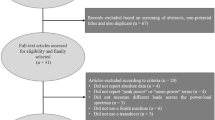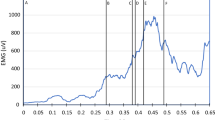Abstract
Catching relies on anticipatory and compensatory control processes. Load uncertainty increases anticipatory and compensatory neuromotor effort in catching. This experiment tested the effect of load uncertainty in plyometric catch/throw training on elbow flexion reaction time (RT), movement time (MT) and peak torque, as well as the distribution of anticipatory and compensatory neuromotor effort in catching. We expected load uncertainty training to be superior to traditional training for improving elbow flexion MT and peak torque, as well as for reallocating neuromotor effort from compensatory to anticipatory control in catching. Three groups of men (mean age = 21), load knowledge training (K) (n = 14), load uncertainty training (U) (n = 13) and control (C) (n = 14), participated. Groups K and U trained three times/week for 6 weeks using single-arm catch/throw exercises with 0.45–4.08 kg balls. Sets involved 16 repetitions of four different ball masses presented randomly. Group K had knowledge of ball mass on every repetition, whereas group U never did. Change scores were analyzed using Kruskal–Wallis tests and follow-up Wilcoxon rank-sum tests. Group K improved both RT and MT (by 6.2 and 12 %, respectively), whereas group U did not. Both groups K and U improved peak eccentric elbow flexion torque. Group K reallocated neuromotor effort from compensatory to anticipatory processes in the biceps, triceps and the all muscle average, whereas group U did so in the triceps only. In sum, plyometric catch/throw training caused a reallocation of neuromotor effort from compensatory to anticipatory control in catching. However, load uncertainty training did not amplify this effect and in fact appeared to inhibit the reallocation of neuromotor effort from compensatory to anticipatory control.






Similar content being viewed by others
References
Alexandrov A, Frolov A, Horak F, Carlson-Kuhta P, Park S (2005) Feedback equilibrium control during human standing. Biol Cybern 93:309–322
Aruin AS, Kanekar N, Lee YJ, Ganesan M (2015) Enhancement of anticipatory postural adjustments in older adults as a result of a single session of ball throwing exercise. Exp Brain Res 233:649–655
Bennett S, Ashford D, Rioja N, Elliott D (2004) Intermittent vision and one-handed catching: the effect of general and specific task experience. J Mot Behav 36:442–449
Berg WP, Hughes MR (2015) The effect of load uncertainty and foreperiod regularity on anticipatory and compensatory neuromotor control in catching. Mot Control. doi:10.1123/mc.2015-0003
D’Andola MD, Cesqui B, Portone A, Fernandez L, Lacquaniti F, d’Avella A (2013) Spatiotemporal characteristics of muscle patterns for ball catching. Front Comput Neurosci 7:107
Darainy M, Ostry DJ (2008) Muscle cocontraction following dynamics learning. Exp Brain Res 190:153–163
Darainy M, Malfait N, Gribble PL, Towhidkhah F, Ostry DJ (2004) Learning to control arm stiffness under static conditions. J Neurophysiol 92:3344–3350
Eckerle JJ, Berg WP, Ward RM (2012) The effect of load uncertainty on anticipatory muscle activity in catching. Exp Brain Res 220:311–318
Hick WE (1952) On the rate of gain of information. Q J Exp Psychol 4:11–26
Houlihan M, Campbell K, Stelmack RM (1994) Reaction time and movement time as measures of stimulus evaluation and response processes. Intelligence 18:289–307
Hyman R (1953) Stimulus information as a determinant of reaction time. J Exp Psychol 45:188–196
Kanekar N, Aruin AS (2015) Improvement of anticipatory postural adjustments for balance control: effect of a single training session. J Electromyogr Kinesiol 25:400–405
Kazennikov OV, Lipshits MI (2010) Influence of preliminary information about the mass on anticipatory muscle activity during the catching of a falling object. Hum Physiol 36:198–202
Keshner EA, Allum JH, Pfaltz CR (1987) Postural coactivation and adaptation in the sway stabilizing responses of normals and patients with bilateral vestibular deficit. Exp Brain Res 69:77–92
Kisner C, Colby LA (2007) Therapeutic exercise: foundations and techniques. F.A. Davis, Philadelphia
Lacquaniti F, Maioli C (1989a) The role of preparation in tuning anticipatory and reflex responses during catching. J Neurosci 9:134–148
Lacquaniti F, Maioli C (1989b) Adaptation to suppression of visual information during catching. J Neurosci 9:149–159
Lang CE, Bastian AJ (1999) Cerebellar subjects show impaired adaptation of anticipatory EMG during catching. J Neurophysiol 82:2108–2119
Oude Nijhuis LB, Allum JH, Valls-Solé J, Overeem S, Bloem BR (2010) First trial postural reactions to unexpected balance disturbances: a comparison with the acoustic startle reaction. J Neurophysiol 104:2704–2712
Pai YC, Bhatt TS (2007) Repeated slip training: an emerging paradigm for prevention of slip-related falls among older adults. Phys Ther 87:1478–1491
Richards B, Berg WP (2012) The feasibility of incorporating load uncertainty into plyometric exercise. In: Annual conference of the Midwest Chapter of the American College of Sports Medicine (MWACSM), Oregon, OH. Unpublished data
Santos MJ, Kanekar N, Aruin AS (2010) The role of anticipatory postural adjustments in compensatory control of posture: 2. Biomechanical analysis. J Electromyogr Kinesiol 20:398–405
Siegmund G, Blouin JS, Inglis TJ (2008) Does startle explain the exaggerated first response to a transient perturbation? Exerc Sport Sci Rev 36:76–82
Thoroughman KA, Shadmehr R (1999) Electromyographic correlates of learning an internal model of reaching movements. J Neurosci 19:8573–8588
Tijtgat P, Bennett SJ, Savelsbergh GJ, De Clercq D, Lenoir M (2010) Advance knowledge effects on kinematics of one-handed catching. Exp Brain Res 201:875–884
Tijtgat P, Vanrenterghem J, Bennett SJ, De Clercq D, Savelsbergh GJ, Lenoir M (2012) Implicit advance knowledge effects on the interplay between arm movements and postural adjustments in catching. Neurosci Lett 518:117–121
Yeomans JS, Frankland PW (1995) The acoustic startle reflex: neurons and connections. Brain Res Rev 21:301–314
Yessis M (2013) Why is plyometrics so misunderstood and misapplied? doctoryessis.com. Retrieved April 12, 2015
Author information
Authors and Affiliations
Corresponding author
Rights and permissions
About this article
Cite this article
Berg, W.P., Richards, B.J., Hannigan, A.M. et al. Does load uncertainty affect adaptation to catch training?. Exp Brain Res 234, 2595–2607 (2016). https://doi.org/10.1007/s00221-016-4664-y
Received:
Accepted:
Published:
Issue Date:
DOI: https://doi.org/10.1007/s00221-016-4664-y




